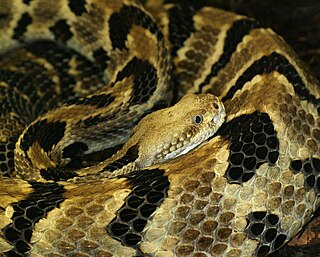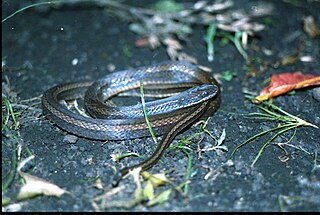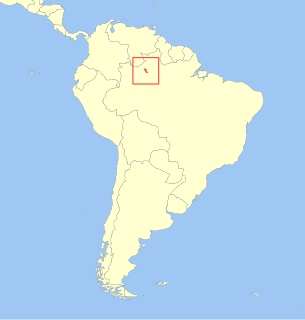
Squamata is the largest order of reptiles, comprising lizards, snakes and amphisbaenians, which are collectively known as squamates or scaled reptiles. With over 10,900 species, it is also the second-largest order of extant (living) vertebrates, after the perciform fish. Members of the order are distinguished by their skins, which bear horny scales or shields. They also possess movable quadrate bones, making it possible to move the upper jaw relative to the neurocranium. This is particularly visible in snakes, which are able to open their mouths very wide to accommodate comparatively large prey. Squamata is the most variably sized order of reptiles, ranging from the 16 mm (0.63 in) dwarf gecko to the 5.21 m (17.1 ft) green anaconda and the now-extinct mosasaurs, which reached lengths of over 14 m (46 ft).

Uakari is the common name for the New World monkeys of the genus Cacajao. Both the English and scientific names are believed to have originated from indigenous languages.

The Crotalinae, commonly known as pit vipers, crotaline snakes, or pit adders, are a subfamily of venomous vipers found in Eurasia and the Americas. They are distinguished by the presence of a heat-sensing pit organ located between the eye and the nostril on both sides of the head. Currently, 22 genera and 151 species are recognized: These are also the only viperids found in the Americas. The groups of snakes represented here include rattlesnakes, lanceheads, and Asian pit vipers. The type genus for this subfamily is Crotalus, of which the type species is the timber rattlesnake, C. horridus.

Aspidites is a genus of pythons endemic to Australia. The name can be translated as "shield bearer" and pertains to the symmetrically shaped head scales. Currently, two species are recognized.
The Anomalepididae are a family of nonvenomous snakes, native to Central and South America. They are similar to Typhlopidae, except that some species possess a single tooth in the lower jaw. Currently, four genera and 15 species are recognized.

The Aniliidae are a monotypic family created for the monotypic genus Anilius that contains the single species A. scytale. Common names include American pipe snake and false coral snake. It is found in South America. This snake possesses a vestigial pelvic girdle that is visible as a pair of cloacal spurs. It is ovoviviparous. It is non-venomous, and its diet consists mainly of amphibians and other reptiles. Currently, two subspecies are recognized, including the typical form described here.

Tantilla melanocephala, commonly known as the black-headed snake, is a species of small colubrid snake endemic to Central America and South America.

The woma python, also known commonly as Ramsay's python, the sand python, and simply the woma, is a species of snake in the family Pythonidae. The species is endemic to Australia. Once common throughout Western Australia, it has become critically endangered in some regions.

The black-headed python is a species of snake in the Pythonidae. The species is native to Australia. No subspecies are currently recognized.

The golden-backed uakari or black-headed uakari, is a New World primate from the family Pitheciidae. It lives in the Amazon Rainforest, and is found in the countries of Brazil, Colombia, and Venezuela. It has black hair covering its body, except for a reddish abdomen, tail, and upper limbs, and a bald face. It has highly specialised teeth which allow it to eat seeds and fruits with hard shells. The name golden-backed uakari is a neotype proposed by Boubli et al. (2008).

Hydrophis melanocephalus, commonly known as the slender-necked sea snake, is a species of venomous sea snake in the family Elapidae.

Coniophanes is a genus of colubrid snakes, typically referred to as black-striped snakes, but they also have many other common names. The genus consists of 17 species, and despite the common name, not all of them display striping.

The Aracá uakari, also known as the Ayres black uakari, is a newly described species of monkey from the northwest Brazilian Amazon. It was found by Jean-Phillipe Boubli of the University of Auckland after following native Yanomamo Indians on their hunts along the Rio Aracá, a northern tributary of the Rio Negro. It was subsequently described in 2008 together with the more westerly distributed Neblina uakari. Until then, the black-headed uakari was the only species of mainly black uakari that was recognized. Stephen F. Ferrari et al proposed treating the Aracá uakari as a subspecies of the black-headed uakari rather than as a separate species.

The Neblina uakari or black-headed uakari, is a newly described species of monkey from the far northwest Brazilian Amazon and adjacent southern Venezuela. It was found by Jean-Phillipe Boubli of the University of Auckland and described together with the more easterly distributed Aracá uakari in 2008. Until then, the black-headed uakari was the only species of mainly black uakari that was recognized.

Meinmahla Kyun Wildlife Sanctuary is a protected area in Myanmar with an extent of 500 km2 (190 sq mi) and one of the ASEAN Heritage Parks. Meinmahla Kyun is an island in the Ayeyarwady Delta ranging in elevation from 0 to 30 m and covered by mangrove forest. It was declared a Ramsar site in 2017.
Melanocephalus is an epithet often used as the second word of a binomial name. It derives from Greek words meaning 'black-headed'. It is used in the names of the following species:

The black-headed ground snake, also known as the Palestine kukri snake is a species of small and elegant harmless snake, which is endemic to the Eastern Mediterranean and the Near East. It belongs to the Colubridae family. Two subspecies, Rhynchocalamus melanocephalus melanocephalus and Rhynchocalamus melanocephalus satunini, are currently recognized.

The western brown snake is commonly known as Mengden's brown snake, and alternatively, gwardar.

Philorhizus melanocephalus is a species of ground beetle in the family Carabidae. It is found in North America, Europe, temperate Asia, and Africa.
Sphenophorus melanocephalus is a species of beetle in the family Dryophthoridae. It is found in North America.















